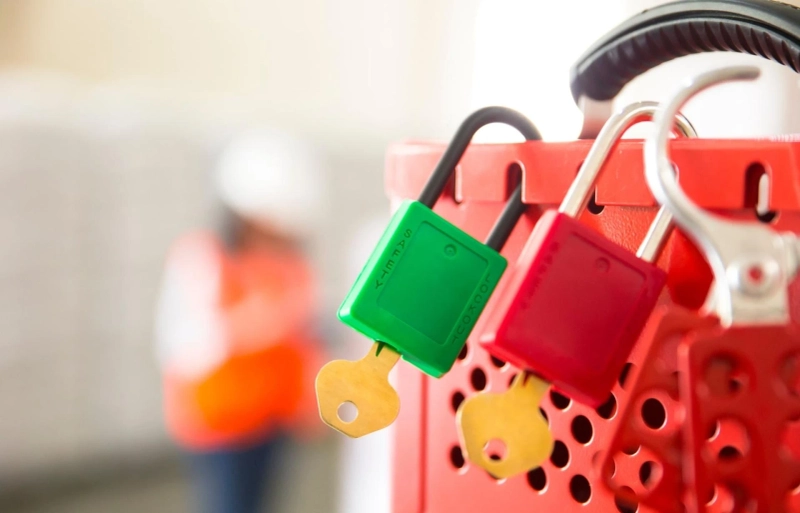When using a lockout device, a lockout padlock is utilised to secure the lockout tagout device in place. This prevents the 'closed off' energy source from being used. In order to obtain access to the energy source, both the padlock and the lockout kit must be removed. Lockout Padlocks are specifically designed to be durable, standardised, significant, and identifiable in order to achieve SWA compliance. Lockout padlocks have high erosion and chemical resistance, can survive temperature fluctuations and are UV stable. With so many lockout/tagout hardware options available, it might be challenging to determine which padlock is best for your individual case. When you factor in the complications of administering lockout/tagout programmes for several departments or sites, the possibilities might become completely bewildering.
As a business owner, you know that ensuring the safety of your employees is a top priority. One way to do this is by using lockout padlocks to prevent accidental or unauthorized starts of equipment. When choosing lockout padlocks, there are several factors to consider, including the type of lock, the material it is made from, and whether it includes a keyed or combination locking mechanism. In this blog post, we will explore these factors in greater detail so that you can make an informed decision when purchasing lockout padlocks for your business.
Choosing the Best Padlock Material
The first step is to determine the appropriate padlock type for your application. There are three different types of materials to consider. The first type of padlock is the nylon padlock, which features a lightweight nylon body with a steel or nylon shackle and is suited for industrial situations. The nylon padlocks with nylon shackles are made of plastic, are non-conductive, and do not spark, making them ideal for electrical and interior applications. For smaller areas, compact padlocks are also available. The ultra-compact and lightweight design with a non-conductive and non-sparking nylon shackle are suitable for electrical contractors, maintenance workers, and electricians working in tight quarters.
The next type of padlock is aluminium padlocks, which have a steel shackle that provides corrosion resistance as well as improved durability for harder industrial applications and outdoor use. Steel padlocks are comprised of reinforced laminated steel that can handle extreme physical stress, as well as a hardened steel shackle with separately coated body plates for better rust resistance.
Choosing the Best Key System for Your Needs
Choosing the best key system for your lockout/tagout programme guarantees that only the right employees have access to lockout equipment during maintenance. These suggestions will assist you in selecting the best alternative for your specific requirements. The first is the various keyed padlocks. Each padlock has a distinct key. It is ideal for preventing key duplication when numerous maintenance people are required to lock out equipment.
Keyed alike padlocks are next. The same key can be used to open each padlock. When numerous locks are given to a single employee, this option comes in handy. It is vital to remember, however, that according to SWA’s laws, no employee should be able to open a lock that has been applied by someone else. As a result, numerous employees should never be given keyed identical locks from the same set. This form of lock is typically utilised when a maintenance worker is in charge of several machines or isolation points. It simplifies key identification and minimises the number of keys on a key ring.
The third type of padlock is the master keyed padlock, which can unlock all locks, including keyed alike and keyed different locks. In the event of an emergency, supervisors can easily remove a lock. To ensure that employees have complete control, master keys should be maintained in a secure location that only management has access to. Last but not least is the Grand master keyed padlocks, which can open all locks in two or more master keyed systems. This is the ideal option for applications with large teams that require various levels of supervisory access. Grand master keys should be kept in a safe location only accessible to management in order for employees to keep exclusive control.
Keeping Track of Your Locks and Keys, and Optimising Your Programme Through Uniformity
When the end user demands no risk of key duplication or for unique padlock choices such as master keyed and grand master keyed padlocks, charting your locks and keys is suggested. Many firms today can track or "chart" your key codes upon request, making it easier to acquire replacement locks and avoid duplicates when ordering extra locks.
When you manage lockout and tagout processes for various departments or sites, standardising your approach can provide your firm with a number of benefits. Lockout and tagout programmes that are most successful incorporate the entire safety picture — locks, tags, and devices, as well as proper lockout procedures, programme documentation, personnel training, periodic inspections, and other procedural features. By establishing a standard, you may order new locks more easily and quickly because you know which lock you need for each application. It can also make training easier because a consistent programme specifies which locks to use and where to find them.
Choosing the right lockout padlock can be difficult. There are so many factors to consider, from the environment you’ll be using it in to the type of lock itself. We hope this article has helped clear up some of the confusion and given you a better idea of what to look for when choosing your safety lockout padlocks. If you have any further questions or need help finding the perfect product for your needs, don’t hesitate to contact us. We have years of experience helping businesses just like yours find the industrial lockout products they need to keep their employees safe and their operations running smoothly.
0


